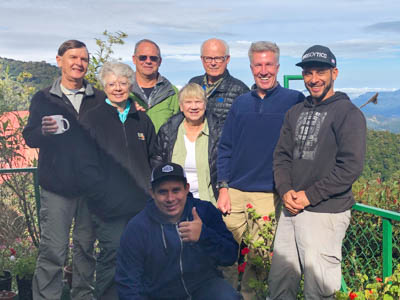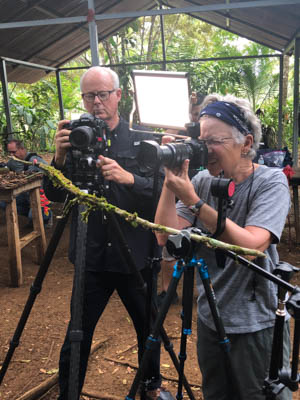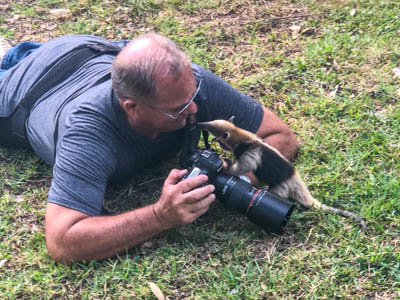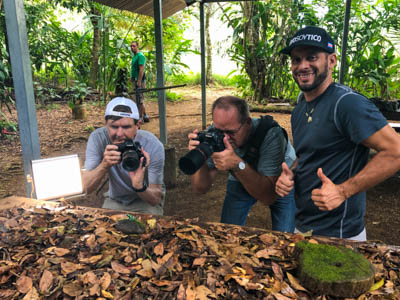Day 1
As we all arrived San Jose for the 2019 Costa Rica Photography Workshop, we met at our hotel which has some of the most beautiful gardens in the city. We will be sharing the beauty of this country with Steve and Ramona from Colorado Springs, Ted and Cheryl from California, and Rick from Denver.
Many of the guests took the opportunity to photograph the gardens and some of the birds that feed on the grounds such as the Lesson’s Motmot.
We all met for dinner and got to know each other, enjoy local cuisine, and talk about the upcoming days of photography. After lots of giggles and stories from this well-traveled group, we called it a night as the photography starts tomorrow.
Day 2

Steve, Ramona, Rick, Cheryl, Ted, Matt, Yehudi and Ricardo enjoy the Costa Rica Highlands.
- Two-toed sloth
- Three-toed sloth
- Sloth babies
- Spectacled owls
- Keel-billed toucan
- Black mandibled toucans
- Neotropical River Otters
- Tamandu (Rick got a close up)
- Kinkaju baby in a tree
- Greater Pooto
- Collared Acari
We got great shots of the sloths at eye level climbing in the trees. Two sloths seemed to cuddle the whole time making the cutest shots. There are not too many animals cuter than sloths.
We then continued our journey to a lodge into the Central Volcanic Mountain Range. We stopped at a scenic water fall and got great shots of the Emerald Toucanet. We then continued to our next lodge after a brief stop to photograph Chestnut-mandibled toucans flying from perch to perch in the trees.
As we arrived at the lodge, we were welcomed to this private 1,000-acre reserve in the Baja de Rio Toro region of Alajuela nestled between the Juan Castro Blanco National park and the Volcán Poás National park. Once we got settled into our rooms, we enjoyed a typical Costa Rican meal, and then discussed hummingbird photography in the evening and how a multi-flash system works in preparation for tomorrow.
Day 3 and Day 4
We spent the next two days at the private lodge and devoted the two days to high speed hummingbird photography. While in the multi-flash hummingbird setups, the guests photographed the following species:
- Green hermit hummingbird
- Brown violet-ear hummingbird
- Lesser violet-ear hummingbird
- Violet sabrewing hummingbird
- Green-crowned brilliant hummingbird
- Talamanca or Magnificent hummingbird
- Purple-throated mountain-gem hummingbird
- Black-bellied hummingbird
- Magenta-throated woodstar hummingbird
While not in the multi-flash setups, the guests walked around the cloud forest reserve and enjoyed the birds that visit this area. We were continually entertained by the White-nosed coati that was up to mischief the whole time trying to steal tasty bananas.
The Central American Agoutis put on a good show as they fed and tried to stay clear of the White-nosed coati’s mischief.
In the evenings, we discussed many different photography techniques and even stepped outside at night to work on different flash techniques that create very artistic lighting, that we nicknamed the Night of the Dead shoot.
Day 5
As we said goodbye to our hosts, and continued to explore Costa Rica, we mounted our landscape lenses and photographed the largest waterfall in Costa Rica, the impressive Catarata Del Toro. Del Toro’s water flows into an ancient volcanic crater with red rock 180 feet below. We had beautiful weather and spent lots of time maximizing all the different compositions of this beautiful waterfall. As we hiked around, we saw Howler monkeys hanging out in a Strangling Fig tree just above our heads.
We then continued our journey arriving around noon at another private reserve where we focused on natural light photography of the hummingbirds and other native birds. The owners of this reserve planted native trees and plants that birds seek out, thereby creating a beautiful and wild sanctuary.

Ted and Ramona photograph a Strawberry poison-dart frog
- White-necked jacobin hummingbird
- Rufous-tailed hummingbird
- Montezuma oropendola
- Golden-hooded tanager
- Crimson-collared tanager
- Green honeycreeper
- Red-legged honeycreeper
- Black-cowled oriole
- Baltimore oriole
- Black-cheeked woodpecker
- Blue-gray tanager
- Scarlet-rumped tanager
- Chachalaca with two chicks
- Chestnut-headed Oropendola
- Green and black poison dart frog
- Palm Tanager
- Summer Tanager
- Clay-colored thrush
While at the reserve we took a little time to practice for our Macro shoot tomorrow and practiced with a Green and Black frog. Everyone got the hang of photographing these neat little creatures.
As the light faded we headed to our hotel for the night and enjoyed a nice dinner, relaxed in the open-air lounging areas and had a few refreshing margaritas. A great end to a full day.
Day 6
Today we spent the day specializing in close-up \ macro frog photography with a local Costa Rican family who has turned their farm acreage into a breeding ground for frogs. They planted vegetation that the frogs prefer, making it the perfect location to photograph the frogs in their natural habitat. We got their early and photographed all the species in different settings. The Crowned Tree frog was certainly a treat for everyone.

Rick has a new buddy. A Tamandua comes up for an up close visit
Some of the frogs we photographed:
- Red-eyed tree frog
- Blue jeans frog or strawberry poison-dart frog
- Green and black poison dart frog
- Glass frog
- Masked Tree Frog
- Crowned Tree Frog
- Nicaragua cross-banded tree frog
While photographing the beautiful frogs, we had a visit from a Black-mandibled toucan that came into perch and pose for its photograph.
In the late afternoon, we said farewell to our new friends and the frogs and continued our journey. You know it was a good shoot as everyone was chimping on the frog images on the drive.
As we climbed to 3,100 feet to the mountain range of the Cordillera Talamancato, we arrived at the lodge in time for a delicious chef prepared dinner.
Day 7 and Day 8
The next two days we set up the multi-flash hummingbird setups to capture hummingbird images with local flowers, as well as natural setups for the hummingbirds. The group really enjoyed photographing the Snowcap hummingbird in natural light. This hummingbird is certainly a challenge, and many got great images of this tiny hummingbird.
The hummingbirds we saw while at the lodge:
- Green hermit hummingbird
- Violet sabrewing hummingbird
- White-necked jacobin hummingbird
- Green-breasted mango hummingbird
- Violet-crowned woodnymph hummingbird
- Rufous-tailed hummingbird
- Snowcap hummingbird
- Green-crowned brilliant hummingbird
- Stripe-throated hermit
Coming to the fruit feeders are local resident and migratory birds. We saw the following:
- Keel-billed Toucan
- Collared aracari
- Montezuma oropendola
- Black-cheeked Woodpecker
- Gray-headed Chachalaca
- Crested Guan
- White-crowned Parrot
- Crimson-fronted Parakeet
- Squirrel Cuckoo
- White-collared Manakin
- Tawny-chested Flycatcher
- Great Kiskadee
- Buff-throated Foliage-gleaner
- Social Flycatcher
- Tropical Kingbird
- Gray-chested Dove
- White-breasted Wood-Wren
- Blue-and-white Swallow
- Brown Jay
- Clay-colored Thrush
Day 9
On our last day in the region, we continued photographing the hummingbirds from the covered terrace and in natural light at the lodge. One of the highlights of the morning was a Tayra coming to the bird feeders and stealing many bananas.
In the afternoon, we packed up our gear, said goodbyes to our hosts, and started the drive to our highest point of the trip.
Gaining vertical to 8,100 feet in elevation we arrived in the rugged mountains of Costa Rica where we stayed at a lodge with new species of hummingbirds, and the beautiful Resplendent Quetzal.
Day 10
We started our day well before sunrise with a guided Resplendent Quetzal tour by a local expert to assist us in our goal of capturing images of one of the most beautiful birds in the world. After achieving our goals quickly and photographing the male and female Resplendent Quetzal on beautiful mossy perches, the local farmers brought us a home cooked breakfast while we were in the field.
We headed back to the lodge for a couple of hours and for lunch. We then headed out to another Quetzal location for the afternoon to early evening. Both the male and female Resplendent Quetzals put on a great show as they brought food back to their young that newly hatched three days ago.
After a long day of photography, we had a nice dinner and called it a night.

Steve and Rick enjoy a little macro photography with a green and black frog
Day 11
Today we spent the morning in the private covered hummingbird setup with fantastic options for flash and natural light photography. This is the best of both worlds.
The activity was incredible and hummingbirds provided us countless opportunities.
Hummingbirds that we photographed today:
- Fiery-throated hummingbird
- Talamanca (Magnificent) hummingbird
- Volcano hummingbird
After lunch, we gathered our gear, said farewell to our hosts, and headed back to the San Jose, Costa Rica.
When we got back to San Jose, we had a little time to pack for the early departures tomorrow and went out to our last group dinner.
Day 12
Our last day of the Costa Rica photography workshop, we all had early morning flights back home.
We had a great group of seasoned travelers, and I don’t remember the last time I laughed so hard all week. Thanks to everyone for making it such a memorable photography workshop.
